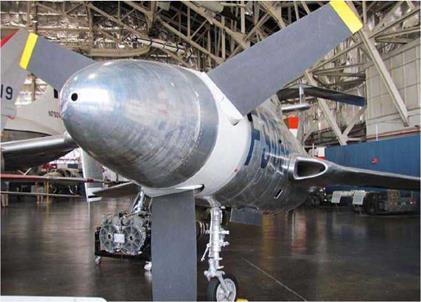Supersonic Propellers
High propeller tip speeds result in the separation of the air flow boundary layer over the blades, causing noise and a loss in efficiency due to compressibility problems. The problems of high tip speed were investigated as far back as 1949-58 in the USA and Europe, when research was conducted on propellers designed to operate in a supersonic air flow. Curtiss Electric built the first supersonic propeller to fly with the first test – flight taking place on the 14th April 1953. The four-blade, 10 feet (3.05 m) prop turned at supersonic speed powered by an Allison XT-38 turboprop engine mounted in the nose of a McDonnell XF-88B Voodoo prototype escort fighter (the forerunner of the F101). Research into supersonic propellers was continued at Edward Air Force Base, California, in 1955.
A modified Republic Thunderstreak, the XF-84H, was used to flight-test the three-blade Aero Products supersonic propeller with a first flight on 22 July 1955. An Allison XT-40-A-1, 5850 ESHP turboprop powered the supersonic prop. The prop was adorned with a very large spinner to mate with the aircraft’s nose, giving the propeller blades a short stubby appearance despite their 12 feet (3.64 m) diameter. The inaudible hypersonic sound waves emanating from the prop during ground running tests caused nausea to nearby personnel and combined with other problems with the prop and engine, the flight-test program was terminated. Many millions of dollars were spent on the project before supersonic props were deemed impractical due to their high noise levels and loss of efficiency at high operating speeds. The research was eventually brought to a close.
|
The Republic Thunderstreak XF-84H used to flight-test the three – blade Aero Products supersonic propeller. The research aircraft is now housed in the National Museum of the USAF in Dayton, Ohio. |
Record Breakers
The quest for high speed and improved aircraft performance has been present ever since the Wright brothers first flew. Speed records were being broken at a steady rate as improvements in aircraft, engines and propeller design allowed. The battle for the Schneider Trophy is a good example of the desire to fly faster. The trophy was captured by the British Supermarine
5.6- b floatplane on 13 September 1931, flown by Flt. J. N. Boothman at an average speed of 340 MPH (295 knots). The Supermarine S.6-B went on to attain 407.5 MPH (354 knots) two weeks after winning the Schneider Trophy The design experience gained on the S.6-B by R. J. Mitchell was to lead on to the design of the Spitfire of World War Two fame. The
5.6- B used a 2300 BHP Rolls Royce R engine, which became the forerunner of the famed Merlin engine, which powered the Spitfire, Hurricane and Lancaster bombers.
The Italian Macchi MC-72 Castoldi, flown by Francesco Agello in 1931, was built to compete for the Schneider trophy but failed to enter. However, it did gain the World’s speed record for floatplanes of 440.68 MPH (385 knots), which this author believes still stands in 2014. It is note worthy the Macchi’s engine was a Fiat 2850 BHP, which powered a contrarotating propeller to combat prop torque; a very powerful engine for such a small plane! All speed records were held by floatplanes during the years 1928 through to 1939 due to the Schneider Trophy challenge, which was only open to floatplanes. The Macchi MC-72 held the overall world speed record for all classes of aircraft until 26 April 1939 when the German Messerschmitt Bf 109R raised the world speed record to 468.9 MPH (408 knots).
Other speed records of interest followed, taken by the Chance Vought F4-U Corsair, Grumman Bearcat and the TU 95/142. The F4-U Corsair fighter of World War Two fame had the largest propeller found on a fighter, radius 13 feet 2 inches
|
The Supermarine S.6-B Schneider Trophy winner on display in the Science Museum, London. |
(4.01 m). The prop was driven by the P&W R-2800 Double Wasp of 2250 BHP, enabling the Corsair to be the first US fighter to exceed 400 MPH (350 knots) during a subsequent test flight on 10 October 1940.
Lyle Shelton’s Grumman F8F Bearcat Rare Bear holds the present world speed record for piston/prop aircraft. The record was gained on 21 August 1989 at 528.31 MPH (460 knots) at Las Vegas, Nevada. The record for the world’s fastest turboprop goes to the Russian TU 95/142 at 545.076 MPH (473 knots) on 9 April 1960. It is claimed by some authorities, the Republic Thunderchief, mentioned earlier with a supersonic prop achieved a speed of 670 MPH (580 knots) during flight test program to become the fastest propeller driven aircraft. However, the National Museum of the USAF in Dayton where the Thunderchief resides, records a lower speed. Did it reach Mach 1? This would have depended on the ambient temperature at the time (the speed of sound varies with temperature) and also, is the claimed speed of 670 MPH correct? No doubt, all these speeds records will be broken again some day in the future.















